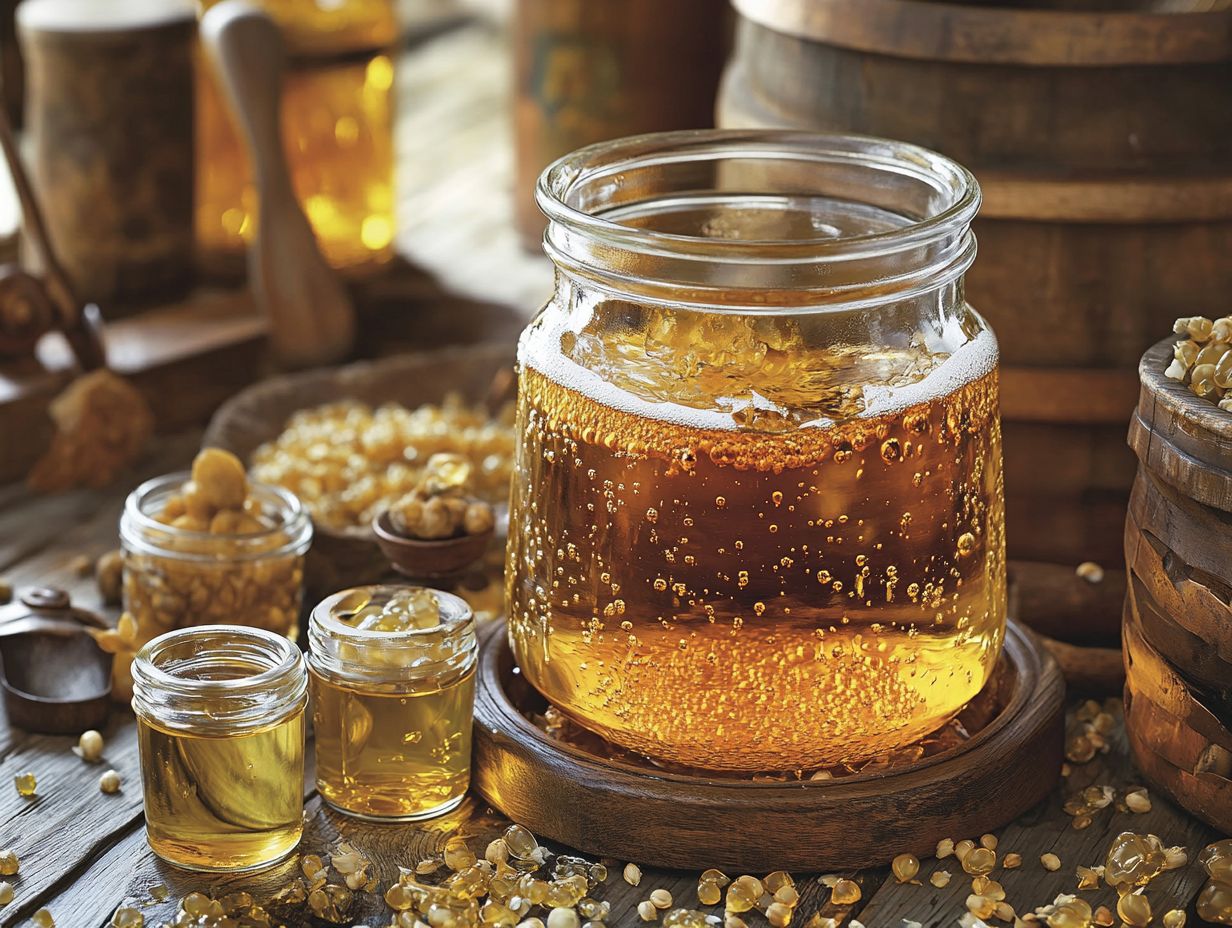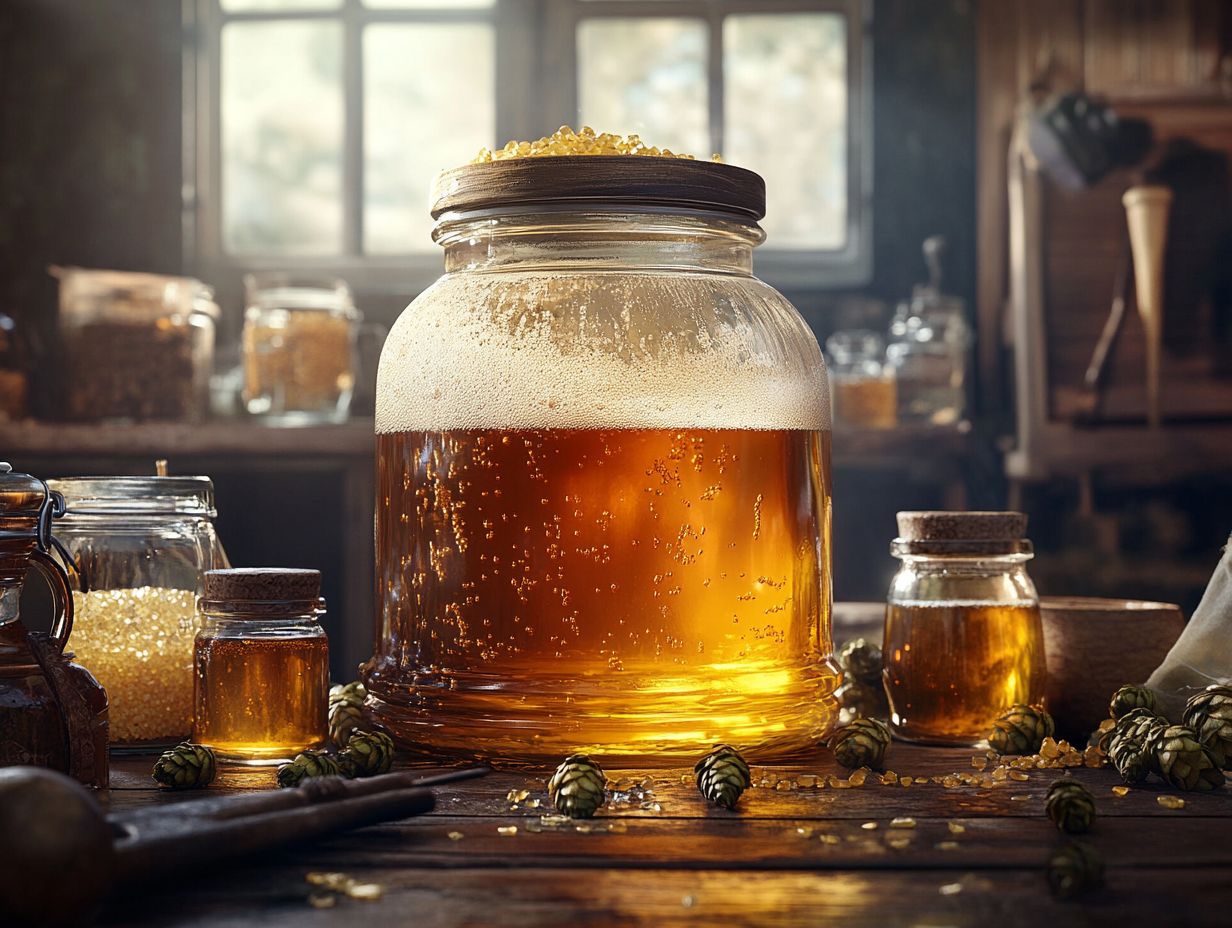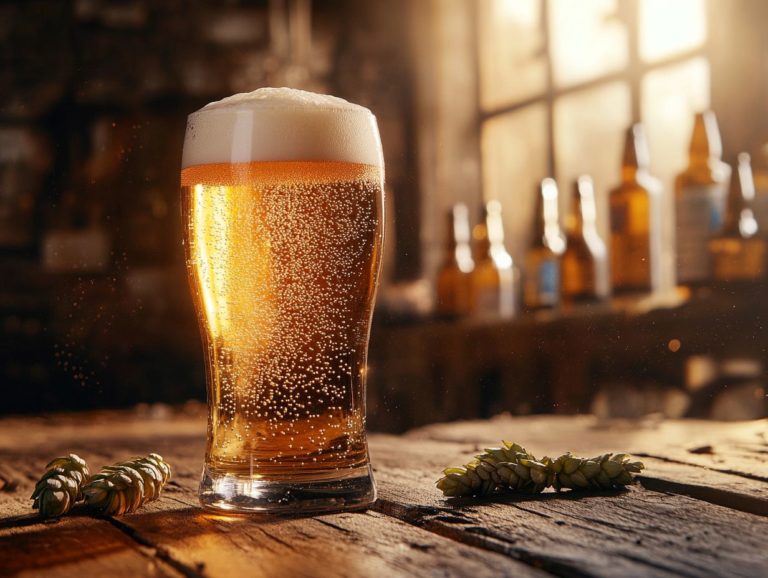How to Use Clarifying Agents in Brewing
Brewing beer is a delightful mix of art and science. Achieving perfect clarity in your brew is vital for both presentation and flavor, whether you’re making Hefeweizens or Hazy IPAs.
Clarifying agents eliminate unwanted particles and enhance the overall quality of your beer. Discover what these agents are, the benefits they provide, and the types available to you as a brewer.
Learn practical tips for selecting the right agent and avoiding common mistakes. Dive into this knowledge to unlock the secrets of crafting a clearer and more enjoyable beer!
Contents
- Key Takeaways:
- What are Clarifying Agents in Brewing?
- Why are Clarifying Agents Used in Brewing?
- What are the Benefits of Using Clarifying Agents in Brewing?
- Types of Clarifying Agents
- 2. Filtering Agents
- 3. Flocculants
- How to Choose the Right Clarifying Agent for Your Beer?
- Factors to Consider When Choosing a Clarifying Agent
- How to Use Clarifying Agents in Brewing?
- Common Mistakes When Using Clarifying Agents
- Using the Wrong Type of Clarifying Agent
- Troubleshooting Common Issues with Clarifying Agents
- Conclusion
- Final Thoughts on Using Clarifying Agents in Brewing
- Frequently Asked Questions
- What are clarifying agents and why are they important in brewing?
- What are some common types of clarifying agents used in brewing?
- How do I know which clarifying agent to use for my beer?
- When should I add clarifying agents to my beer?
- Can I use multiple clarifying agents in one batch of beer?
- Are there any risks or side effects of using clarifying agents in brewing?
Key Takeaways:

- Using clarifying agents improves the clarity, flavor, and stability of your beer.
- Consider the type of beer, desired outcome, and potential allergens when choosing a clarifying agent.
- Proper usage and troubleshooting can help avoid mistakes and achieve the best beer clarity and taste.
What are Clarifying Agents in Brewing?
Clarifying agents significantly enhance the visual clarity of various beer styles, such as Hefeweizens and Hazy IPAs. They reduce unwanted hazes from biological sources like yeast, as well as nonbiological sources such as proteins and polyphenols.
These agents help reduce chill haze, a common issue. As a homebrewer or craft beer enthusiast, you can use a variety of clarifying agents to create a visually appealing and stable final product.
Why are Clarifying Agents Used in Brewing?
Clarifying agents are crucial for maintaining stability and enhancing the visual appeal of your beer. By using them, you can minimize chill haze and improve clarity, which is important for both homebrewers and commercial producers.
This process enhances visual clarity and influences the flavor profile and shelf life of the beer. Understanding how these agents work will help you make informed decisions based on your specific beer styles.
What are the Benefits of Using Clarifying Agents in Brewing?
Using clarifying agents in your brewing process brings a multitude of benefits, including improved clarity, enhanced stability, and an overall more appealing final product. These agents play a crucial role in managing yeast and protein interactions that can lead to different types of haze, like chill haze and yeast haze. By effectively minimizing these unwanted components, you can create visually stunning beers that delight consumers in both homebrew and craft beer markets.
Techniques such as cold crashing and patience are also key to achieving clear beer. Incorporating clarifying agents into your brewing techniques not only streamlines production but can also shorten fermentation times, making life easier for both amateur and professional brewers.
The use of brewing clarifiers like kettle finings, Whirlfloc, and pectic enzyme can greatly assist in this process. Beyond just aesthetics, the influence of these agents on flavor profiles is significant; they help refine and elevate desirable notes while reducing off-flavors that may arise from haze-related instability.
You can see successful applications across various beer styles from lagers that thrive on a crisp, clear appearance to hazy IPAs that, when managed judiciously, achieve a harmonious balance between haze and clarity. The innovative use of clarifying agents allows you to enhance mouthfeel without compromising flavor integrity, resulting in a superior drinking experience that resonates with both craft beer aficionados and newcomers alike.
Start incorporating these agents in your brewing today to unlock the full potential of your craft!
Types of Clarifying Agents
In the brewing process, you’ll encounter various types of clarifying agents, each designed to enhance the clarity and quality of your beer. Fining agents like gelatin and Irish Moss are commonly employed to remove unwanted particles, promoting that coveted clarity. Options like Whirlfloc and Clarity Ferm are also available for specialized needs.
Filtering agents and flocculants play essential roles in aiding sedimentation and improving the filtration process, which is crucial for achieving that desired clear beer appearance. Common filtering agents include diatomaceous earth and cellulose-based filters.
As a homebrewer or craft beer producer, it s important for you to understand the different categories of clarifying agents available. This knowledge will give you the power to select the right ingredients tailored to your specific brewing needs.
1. Fining Agents
Fining agents play a vital role in brewing, serving as essential clarifying agents that enhance the visual clarity of your beer by removing unwanted particles and sediment. Traditional products like Irish Moss and gelatin excel in this area, binding to hazy compounds such as proteins and polyphenols, facilitating their removal during the brewing process.
If you re looking for vegan-friendly options, alternatives like Biofine Clear allow you to cater to diverse consumer preferences while still achieving that crystal-clear final product. Understanding the characteristics and mechanisms of these fining agents is key for you as a brewer aiming to refine your craft.
While traditional options like isinglass and gelatin are effective in promoting bright clarity and stability, they can present challenges if you prefer to stick with vegan ingredients. Modern fining solutions often employ enzymes that specifically target haze-forming compounds without compromising flavors or aromas, thereby expanding your toolkit as a brewer.
By carefully evaluating the pros and cons of each fining agent, you can make informed choices that align your production methods with your desired outcomes, ultimately enhancing the overall quality and appeal of your beer.
2. Filtering Agents
Filtering agents are a crucial element in the beer filtration process, essential for achieving a clear and visually captivating final product. These agents help remove leftover yeast, proteins, and other particles that can lead to a hazy appearance, thereby enhancing the clarity of your beer.
When used effectively, filtering agents elevate the aesthetic qualities of craft beer and contribute to greater stability and shelf life critical factors for both homebrewers and commercial breweries alike.
In the brewing community, you’ll discover various types of filtering agents. Each serves distinct roles based on specific circumstances. For instance, commercial brewers often turn to diatomaceous earth or cellulose-based filters for their large-scale production needs. Homebrewers may opt for gelatin or isinglass for a more hands-on approach.
Each filtering agent comes with unique properties and varying effectiveness in removing undesirable particles. By understanding how these agents interact with your beer, you can greatly influence its appearance, flavor profile, and overall quality.
As the brewing industry continues to evolve, embracing innovative filtration techniques will further enhance the clarity and overall experience of your final brew.
3. Flocculants

Flocculants are your secret weapon in achieving that crystal-clear beer you desire. These specialized clarifying agents work wonders by promoting the clustering and settling of yeast and other particulates, leading to impressive clarity in your final brew. During the brewing process, these agents encourage yeast to come together and settle efficiently, which can drastically cut down the time needed for fermentation and conditioning.
By grasping the role of flocculants, you whether a homebrewer or a craft brewer can refine your brewing practices to secure a cleaner and more visually appealing finish.
There are various types of flocculants gelatin, isinglass, and bentonite, to name a few each bringing its unique benefits to different fermentation conditions and beer styles. For instance, Biofine Clear and PolyChar are excellent choices for different beer styles like Hefeweizens and Hazy IPAs.
For example, certain flocculants shine when crafting crisp, pale lagers where clarity is essential. Others might excel in producing hazy IPAs, where a hint of cloudiness can actually elevate the experience.
By strategically utilizing these agents, you influence yeast behavior, encouraging quicker settling and minimizing the risk of off-flavors. Ultimately, selecting the right flocculants can significantly enhance the quality and market appeal of your final product.
How to Choose the Right Clarifying Agent for Your Beer?
Choosing the perfect clarifying agent can transform your beer from good to amazing! It requires a keen understanding of the distinct needs of your brewing process and the specific characteristics you wish to achieve in the final product. Consider the roles of flaked grains, dry hopping, hot break, and cold break in your decision. (Hot break refers to the coagulation of proteins during boiling, while cold break occurs as the wort cools, helping to clarify the beer.)
Considerations such as the beer style, fermentation process, and the level of visual clarity you desire are all pivotal in determining the most effective clarifying agent. Whether you’re a homebrewer or a craft brewer, you should thoughtfully evaluate the array of brewing techniques at your disposal, including the use of brewing strains and brewing alternatives.
From traditional agents like Irish Moss and kettle finings to contemporary alternatives such as Clarity Ferm and PolyChar, tailoring your approach to each unique brewing scenario is essential for achieving the best results.
Factors to Consider When Choosing a Clarifying Agent
When selecting a clarifying agent, it s essential to consider several key factors to ensure you achieve optimal results in your brewing process. You ll want to think about the specific beer styles you’re producing, the type of biological and nonbiological hazes you need to address, and the level of visual clarity you desire in the final product.
Evaluate how different brewing ingredients and techniques like dry hopping and using flaked grains interact with your chosen clarifying agent. This compatibility can significantly influence the overall outcome of your beer.
Your selected agent should harmonize with your brewing recipe and the unique characteristics of the ingredients you re using. Certain clarifiers may perform better with specific malts, hops, or other ingredients like tannins and polyphenols. For example, a lager might require a different clarifier than a wheat beer or Hefeweizen due to variations in the causes and textures of haze.
It s also crucial to consider how factors like fermentation temperature and the fermentation process come into play. These elements can impact not just clarity but also flavor and stability. Cold crashing, which is the process of cooling beer rapidly to help sediment settle faster, is another technique to further enhance clarity.
Ultimately, a thoughtful assessment of these components can lead you to a clearer, more well-defined beer that aligns perfectly with your brewing vision.
How to Use Clarifying Agents in Brewing?
Using clarifying agents in brewing demands your perfect timing and precise techniques to fully harness their potential for enhancing beer clarity. Typically, these agents are introduced at specific stages of the brewing process such as during fermentation or conditioning to help them work against unwanted particles like yeast and sediment.
A well-structured guide can assist both homebrewers and craft beer aficionados in effectively incorporating clarifying agents, ensuring that you achieve the desired clarity and stability in your finished brews.
Step-by-Step Guide to Using Clarifying Agents
A step-by-step guide to using clarifying agents empowers you to effectively incorporate these essential components into your brewing process for optimal clarity and stability.
- Start by identifying the type of clarifying agent that suits your beer style think Irish Moss or Whirlfloc for those Hazy IPAs or gelatin and isinglass for refreshing Hefeweizen.
- Next, pinpoint the right moment to add it, typically during the cooling phase or after fermentation, ensuring it interacts correctly with yeast, sediment, and other particulates like protein-polyphenol complexes.
- Watch the sedimentation process and evaluate the clarity of your beer before moving on to beer filtration, ensuring you produce a crystal-clear final product.
Understanding how different clarifying agents function can substantially elevate your brewing experience, as each agent plays a unique role in the clarification process. For example, Biofine Clear, pectic enzyme, and Polyclar AT each offer unique benefits. For the best results, dive deep into research and choose an agent that complements the specific characteristics of your brew.
Timing is everything adding the clarifying agent too early or too late can lead to less-than-ideal outcomes. By observing your beer s clarity over time and adjusting your approach based on visual cues, you ll be well on your way to achieving the desired clarity.
By focusing on these aspects, you ll create a visually appealing beer that showcases your skills. These thoughtful considerations, brewing alternatives, and monitoring techniques will significantly contribute to producing a visually appealing and stable final product that reflects your brewing expertise.
Common Mistakes When Using Clarifying Agents
You may encounter several common mistakes when using clarifying agents in your brewing process. These can lead to less-than-desirable outcomes in both clarity and quality, significantly impacting your enjoyment of the beer.
One frequent misstep is using too much or too little of the clarifying agent. This can either overwhelm the brewing process or fail to properly clear the beer. Neglecting to follow the manufacturer s instructions or choosing the wrong type of clarifying agent for your specific beer style could also result in stability issues and off-flavors.
Recognizing these pitfalls can supercharge your brewing skills and help you achieve better clarity and quality in your final products.
1. Using Too Much or Too Little Clarifying Agent
One of the most prevalent pitfalls brewers encounter is the improper use of clarifying agents. This can be either too much or too little. Such a misstep can significantly affect both the clarity and quality of your beer, leading to issues like chill haze or permanent haze.
The repercussions of using clarifying agents incorrectly reach far beyond mere appearance; they can deeply affect the overall sensory experience of the beer. For instance, overdoing it might strip away delicate flavor nuances, resulting in a brew that feels dull and lifeless. On the other hand, using too little can lead to excessive cloudiness or a hazy appearance, which may deter potential consumers.
To achieve the perfect balance, consider the specific beer style and the production techniques you’re employing. For lighter beers, a more restrained approach is often best, while fuller-bodied styles may thrive with slightly elevated levels.
By becoming more familiar with the brewing process and regularly experimenting, you can pinpoint the optimal usage of clarifying agents. This ensures that both clarity and flavor integrity are beautifully preserved.
2. Not Following the Instructions

Neglecting to follow the manufacturer’s instructions for clarifying agents can lead to ineffective results and negatively impact your brewing process. Each clarifying agent comes with specific guidelines about when and how to add it, along with recommended dosages for various beer styles.
If you overlook these instructions, you risk misjudging the agent’s effects. This can result in undesirable clarity, beer filtration, and flavor profiles in your finished brew. Not adhering to these precise recommendations could lead to excessive haze or overly aggressive clarification that strips away essential flavors and aromas.
It’s crucial to thoroughly read the complete guidelines, paying attention to the unique characteristics of each clarifying agent. Starting with small test batches is a wise move, allowing you to make adjustments in dosage and timing based on the results.
Keeping detailed notes on each brewing session will refine your approach further, ensuring that your final product is not only crystal clear but also retains the desirable taste and mouthfeel you strive for.
So go ahead and experiment with clarifying agents in your next brewing session. Applying these tips can help you create the perfect brew!
Using the Wrong Type of Clarifying Agent
3. Using the Wrong Type of Clarifying Agent
Using the wrong type of clarifying agent for your beer style can hinder your brewing process. It can also compromise the final product’s clarity.
Different agents like Super Kleer, Polyclar AT, and Bentonite Clay are tailored to work harmoniously with particular ingredients and brewing techniques. Choosing an incompatible clarifying agent could leave you with insufficient clarity or, worse yet, some undesirable off-flavors. That s why understanding the characteristics of various clarifying agents is essential for you if you want to achieve the best possible results in your chosen beer styles.
Selecting a clarifying agent that doesn t align with your outcome risks cloudiness. It may also lead to flavor degradation, detracting from your drinking experience.
For instance, a fining agent that works wonders in a lager might not perform the same magic in an ale or a Blonde Ale, leaving you puzzled about the product’s final profile.
To steer clear of these pitfalls, it s highly beneficial for you to engage in research, attend workshops, and connect with industry experts. This will deepen your understanding of how different agents interact with specific ingredients and brewing strains.
By doing so, you ll be equipped to make informed decisions that align with your brewing goals, ultimately resulting in a clearer, more flavorful beer.
Troubleshooting Common Issues with Clarifying Agents
Troubleshooting common issues with clarifying agents is crucial for attaining that perfect beer clarity and quality you desire. You should also know that issues like cloudy beer, excessive foam during pouring, and unwanted off-flavors often stem from the clarifying agents you choose or how you apply them.
Sometimes using the wrong clarifying agent can even cause issues with settling and sediment, which disrupts the visual clarity of the beer.
By grasping the underlying causes of these challenges, you can make informed adjustments to your brewing processes and ingredient selections, paving the way for enhanced results and greater satisfaction in your brewing endeavors.
Patience is also key; sometimes, the best results come from allowing the clarifying agents sufficient time to work their magic.
1. Cloudy Beer
Cloudy beer is one of the primary challenges you might face when using clarifying agents, often stemming from insufficient sedimentation or ineffective application of those agents. Several factors can contribute to cloudiness, including an imbalance in the interactions between yeast and protein, or improper usage of clarifying agents, which can impede the removal of haze-causing particles.
Sometimes, issues like hot break and cold break can also lead to cloudiness. Understanding these elements is essential if you aim to enhance your beer’s clarity and deliver a visually stunning final product.
Several variables are crucial in achieving a clear brew, such as fermentation temperature, yeast health, and the specific clarifying agents you choose to use.
For example, if you’re not careful during racking or if you fail to monitor fermentation closely, you might inadvertently introduce excess yeast into the final product.
Using clarifying agents like Pectinase or Sparkolloid can significantly improve clarity for certain beer styles.
To combat cloudiness, consider fine-tuning your fermentation process controlling temperature and ensuring proper yeast flocculation can significantly boost clarity.
Selecting the right clarifying agents, like isinglass or gelatin, and following the recommended usage guidelines can help you attain that sought-after crystal-clear finish.
Refining these processes will help you create that stunning, crystal-clear beer you’ve always wanted!
Conclusion
Understanding the role of clarifying agents is essential for achieving clarity and quality in your brewing process. By recognizing the challenges and employing effective techniques, you can enhance both the appearance and taste of your beers.
2. Causes of Excessive Foam
Excessive foam can crop up when using clarifying agents, often stemming from an imbalance between proteins and natural compounds found in plants during the brewing process. You might find that certain agents don t play nicely with the ingredients in your beer, causing the yeast to go into overdrive and leading to unwanted foam production. Understanding the root causes of excessive foam is crucial for anyone looking to craft a well-balanced and enjoyable final product.
To tackle this challenge effectively, consider adjusting the concentration of clarifying agents in your recipes. Experimenting with different formulations can help reduce the aggressive foam formation that specific clarifiers can cause. Keep a close eye on pH levels throughout the brewing process, as this significantly impacts how your ingredients interact, ensuring a harmonious blend.
Implementing cold crashing techniques, a process of rapidly cooling beer to clarify it, or fine-tuning your fermentation practices may also help alleviate foaming issues while maintaining optimal clarity. By making these thoughtful adjustments, you can elevate the overall quality of your brews, delivering an enhanced drinking experience that your customers will appreciate.
3. Off-Flavors
Off-flavors in beer often stem from improper usage or selection of clarifying agents, which can significantly impact both the taste and aroma of your final product. These unwanted flavors may emerge when agents degrade or interact unfavorably with other ingredients during the brewing process, ultimately resulting in a less-than-satisfactory drinking experience. For you, as a homebrewer or craft beer enthusiast, grasping how to sidestep these pitfalls is essential for crafting high-quality beers that fulfill consumer expectations.
Choosing the right clarifying agents, such as fining agents or filtration systems, and applying them correctly can make a world of difference. For example, excessive use can result in astringent or grainy flavors, while insufficient application might leave you with haze-causing compounds that detract from the overall experience.
To mitigate off-flavors, carefully evaluate ingredient compatibility and adhere to recommended dosages, allowing ample time for clarification. Monitoring fermentation conditions and maintaining proper sanitation throughout the brewing process can significantly reduce potential interactions that lead to undesirable taste profiles.
By following these exciting techniques, you can elevate the overall quality and enjoyability of your beers, transforming each brew into a delightful experience.
Final Thoughts on Using Clarifying Agents in Brewing
Clarifying agents are critical tools in your brewing toolkit, whether you’re a homebrewer or a craft beer producer. By grasping the various types of clarifying agents available and knowing how to apply them effectively, you can significantly enhance the clarity and overall quality of your beer. This not only boosts the aesthetic appeal of your products but also ensures their stability and flavor integrity.
These agents such as gelatin, isinglass, and polyclar are critical for minimizing haze and sediment in your finished beers. As you embark on your journey to craft the perfect brew, it’s essential to recognize that each clarifying agent possesses its own unique characteristics and effects. Experimenting with different options could lead to surprising and delightful results that elevate your brewing game.
Patience is key throughout this process. Developing a thorough understanding of these techniques will refine your skills and enhance the quality of the beer you produce. So, don t hold back immerse yourself in the world of clarifying agents and uncover how they can transform an ordinary brew into something truly exceptional.
Frequently Asked Questions

What are clarifying agents and why are they important in brewing?
Clarifying agents are substances used in the brewing process to remove haze-causing particles and improve the appearance and clarity of the final beer. They are important because clarity is a key characteristic of a well-crafted and visually appealing beer.
What are some common types of clarifying agents used in brewing?
Some common types of clarifying agents used in brewing include isinglass, gelatin, Irish moss, and whirlfloc tablets. Other natural options include egg whites and seaweed-derived carrageenan.
Clarifying agents play a vital role in brewing by helping to clear your beer of unwanted particles. Understanding which agents to use and when can lead to a clearer, more enjoyable brew.
How do I know which clarifying agent to use for my beer?
The type of clarifying agent to use depends on the type of beer you are brewing and personal preference. For example, gelatin is effective for removing yeast and protein haze in lighter beers, while isinglass, a fish-derived product, is better suited for dark beers.
When should I add clarifying agents to my beer?
The timing of adding clarifying agents varies depending on the specific agent and the desired result. For example, Irish moss, which is a type of seaweed that helps clarify beer, is added during the last 15 minutes of the boil. Gelatin is added after fermentation is complete.
Can I use multiple clarifying agents in one batch of beer?
Yes, you can use multiple clarifying agents in one batch of beer. Many brewers use a combination of agents to achieve the desired level of clarity and remove various types of haze.
Are there any risks or side effects of using clarifying agents in brewing?
When used correctly, clarifying agents can be a game-changer for your beer’s clarity! They are safe and should not negatively impact the flavor or aroma of your beer. However, it is important to carefully follow instructions and dosage recommendations to avoid over-treating your beer.






